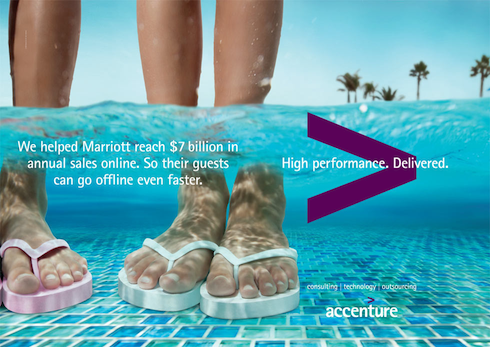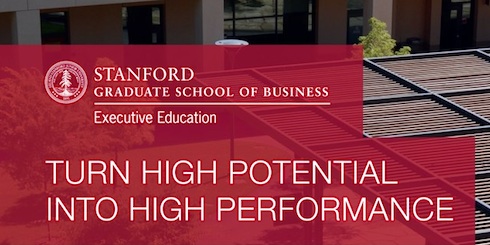Velocity Farewell
Velocity Origin Story
In 2007, my first book, High Performance Web Sites, was selling very well. That, plus the launch of YSlow, brought more attention to web performance. As a result, Jon Jenkins invited me to give a tech talk at Amazon. Afterward, he, John Rauser, and I, plus a few other performance-minded folk, had a great dinner and spirited discussion about performance best practices. Jon asked me if there was any place where people got together to have that type of discussion. I couldn’t think of one so promised to talk to O’Reilly about the idea of a conference.
I emailed my editor, Andy Oram, and asked if he thought a performance conference was a good idea. He agreed to setup a meeting with Tim O’Reilly at OSCON. That meeting included people that I would end up working closely with for the next decade: Tim, Andy, Gina Blaber, Brady Forrest, Jon Jenkins, Artur Bergman, and Jesse Robbins. (There were others there as well and I apologize for not remembering.) I’m not sure, but I think Jon invited Jesse to the meeting. Both of them worked at Amazon where Jesse was the “master of disaster” – helping to create a resilient infrastructure for their services.
We discussed the idea of a conference combining performance and operations. It made sense. Both groups (or “tribes” as Jesse called them) focused on optimization. The tools and stacks might have been different, but the mindset was the same. The first Velocity was held June 2008. Jesse and I were the co-chairs. I remember being surprised and grateful when Gina called me to ask if I would co-chair. It seems like that was a long time ago.
Take a look at the speaker list for that first Velocity – it contains many people who were or would become luminaries in emerging fields of DevOps and WPO – Web Performance Optimization (aka, FEO – Frontend End Optimization):
- John Allspaw – future Velocity co-chair, current CTO at Etsy
- Artur Bergman – founder of Fastly and who would become my future boss
- Eric Goldsmith – worked with Pat Meenan at AOL on WebPageTest
- Jason Grigsby – mobile guru with me this week at Velocity again!
- Adam Jacob -Â CTO at Chef
- Luke Kanies – founder of Puppet Labs
- Eric Lawrence – OMG! Internet Explorer, Fiddler, now Google Chrome
- John Rauser – OMG! Amazon, Pinterest, Snapchat, also with me this week at Velocity again!
- Eric Schurman – Microsoft, now Amazon, and still on the Velocity Program Committee
- Stoyan Stefanov – member of the original Yahoo! Exceptional Performance team, creator of the Performance Calendar, now at Facebook
- Mandi Walls – keynoted at the very first Velocity, and sitting with me now in the Velocity speaker room again!
Transition
Yesterday, I announced this is my last Velocity as co-chair. I’ve been doing Velocity for a long time: nine years comprised of 21 shows (9 in California, 6 in Europe, 4 in New York, and 2 in Beijing). It feels good to open up the opportunity for someone else. Courtney Nash, who owns Velocity at O’Reilly, announced that performance will be merged with Fluent in 2017 to be chaired by Kyle Simpson and Tammy Everts. Also, Inés Sombra is the new co-chair for Velocity. The future looks good.
So many thank yous: O’Reilly Media for starting Velocity (and pushing me to accept that name over my choice, “Web Performance Conference”). Jesse Robbins, John Allspaw, James Turnbull and Courtney Nash for accepting me (putting up with me) as a Velocity co-chair. All the Program Committee members. The sponsors and vendors who supported Velocity. The amazing speakers over these past nine years. And all the attendees. We should pat each other on the back – it’s important to do that every once-in-a-while. We have created a strong, smart, caring, supportive community. Out of that have come numerous industries, technologies, and companies.
It has been an amazing experience. Thank you!
Velocity highlights (video bonus!)
We’re in the quiet period between Velocity Santa Clara and Velocity New York. It’s a good time to look back at what we saw and look forward to what we’ll see this September 15-17 in NYC.
Velocity Santa Clara was our biggest show to date. There was more activity across the attendees, exhibitors, and sponsors than I’d experienced at any previous Velocity. A primary measure of Velocity is the quality of the speakers. As always, the keynotes were livestreamed. The people who tuned in were not disappointed. I recommend reviewing all of the keynotes from the Velocity YouTube Playlist. All of them were great, but here were some of my favorites:
 |
Virtual Machines, JavaScript and Assembler – Start. Here. Scott Hanselman’s walk through the evolution of the Web and cloud computing is informative and hilarious. |
 |
Lowering the Barrier to Programming – Pamela Fox works on the computer programming curriculum at Khan Academy. She also devotes time to Girl Develop It. This puts her in a good position to speak about the growing gap between the number of programmers and the number of programmer jobs, and how bringing more diversity into programming is necessary to close this gap. |
 |
Achieving Rapid Response Times in Large Online Services – Jeff Dean, Senior Fellow at Google, shares amazing techniques developed at Google for fast, scalable web services. |
 |
Mobile Web at Etsy – People who know Lara Swanson know the incredible work she’s done at Etsy building out their mobile platform. But it’s not all about technology. For a company to be successful it’s important to get cultural buy-in. Lara explains how Etsy achieved both the cultural and technical advances to tackle the challenges of mobile. |
 |
Build on a Bedrock of Failure – I want to end with this motivational cross-disciplinary talk from skateboarding icon Rodney Mullen. When you’re on the bleeding edge (such as skateboarding or devops), dealing with failure is a critical skill. Rodney talks about why people put themselves in this position, how they recover, and what they go on to achieve. |
Now for the bonus! Some speakers have posted the videos of their afternoon sessions. These are longer, deeper talks on various topics. Luckily, some of the best sessions are available on YouTube:
 |
Is TLS Fast Yet? – If you know performance then you know Ilya Grigorik. And if you know SPDY, HTTP/2, privacy, and security you know TLS is important. Here, the author of High Performance Browser Networking talks about how fast TLS is and what we can do to make it faster. |
 |
GPU and Web UI Performance: Building an Endless 60fps Scroller – Whoa! Whoa whoa whoa! Math?! You might not have signed up for it, but Diego Ferreiro takes us through the math and physics for smooth scrolling at 60 frames-per-second and his launch of ScrollerJS. |
 |
WebPagetest Power Users Part 1 and Part 2 – WebPagetest is one of the best performance tools out there. Pat Meenan, creator of WebPagetest, guides us through the new and advanced features. |
 |
Smooth Animation on Mobile Web, From Kinetic Scrolling to Cover Flow Effect – Ariya Hidayat does a deep dive into the best practices for smooth scrolling on mobile. |
 |
Encouraging Girls in IT: A How To Guide -Â Doug Ireton and his 7-year-old daughter, Jane Ireton, lament the lack of women represented in computer science and Jane’s adventure learning programming. |
If you enjoy catching up using video, I recommend you watch these and other videos from the playlist. If you’re more of the “in-person” type, then I recommend you register for Velocity New York now. While you’re there, use my STEVE25 discount code for 25% off. I hope to see you in New York!
Web Performance Community & Conversation
I first started talking about web performance in 2007. My first blog post was The Importance of Front-End Performance over on YDN in March 2007. The next month Tenni Theurer and I spoke at Web 2.0 Expo on High Performance Webpages. I hadn’t spoken at a conference since 1990 – 17 years earlier! This speaking appearance was before YSlow and my book High Performance Web Sites had been released. There was no conversation around web performance at this time – at least none that I was aware of.
Our 3 hour (!) workshop was schedule for 9:30am on a Sunday morning. Tenni and I thought we were doomed. I told her we should expect 20 or so people, and not to be disappointed if the audience was small. I remember it was a beautiful day in San Francisco and I thought to myself, “If I was here for a conference I would be out touring San Francisco rather than sitting in a 3 hour workshop at 9:30 on a Sunday morning.”
Tenni and I were surprised that we’d been assigned to a gigantic ballroom. We were also surprised that there were already 20+ people there when we arrived early to setup. But the real surprise came while we sat there waiting to start – nearly 300 people flowed into the room. We looked at each other with disbelief. Wow!
Constant blogging, open sourcing, and public speaking carried the conversation forward. The first Velocity conference took place in June 2008 with ~500 attendees. Velocity 2012 had ~2500 attendees, and now takes place on three continents. The conversation has certainly grown!
That was a fun look at the past, but what I really wanted to do in this blog post was highlight three critical places where the web performance conversation is being held now.
- Web Performance Meetups – Sergey Chernyshev started the New York Web Performance Group in April 2009. Today there are 46 Web Performance meetups with 16,631 members worldwide. Wow! This is a huge community and a great format for web performance enthusiasts to gather and share what they’ve learned to continue to make the Web even faster.
- Exceptional Performance mailing list – I started the Exceptional Performance team at Yahoo! In doing so I also created the Exceptional Performance Yahoo! Group with its associated mailing list. This group has atrophied in recent years, but I’m going to start using it again as a way to communicate to dedicated web performance developers. It currently has 1340 members and the spam rate is low. I encourage you to sign up and read & post messages on the list.
- PerfPlanet.com – I’ll be honest – I think my blog is really good. And while I encourage you to subscribe to my RSS feed, it’s actually more important that you subscribe to the feed from PerfPlanet.com. Stoyan Stefanov, another former member of the Exceptional Performance team, maintains the site including its awesome Performance Calendar (now in its fourth instantiation). Stoyan has collected ~50 of the best web performance blogs. This is my main source for the latest news and developments in the world of web performance.
It’s exciting to see our community grow. I still believe we’re at the tip of the iceberg. Back in 2007 I would have never predicted that we’d have 16K web performance meetup members, 2500 Velocity attendees, and 1340 mailing list members. I wonder what it’ll be in 2014. It’s fun to imagine.
WebPerfDays: Performance Tools
I just returned from Velocity Europe in London. It was stellar. And totally exhausting! But this post is about the other fantastic web performance event that took place after Velocity: WebPerfDays London.
WebPerfDays is like a day-long web performance meetup event. Aaron Kulick organized the first one last June right after Velocity US. He had the brilliant idea to grab webperfdays.org with the goal of starting a series of events modeled after DevOpsDay. The intent is for other people to organize their own WebPerfDays events. All the resources are meant to be shared – the website, domain, templates, Twitter handle, etc.
Stephen Thair continued the tradition by organizing last week’s WebPerfDays in London. It was held at Facebook’s new London office. They contributed their space on the top floor with beautiful views. (Sorry for the broken sofa.) WebPerfDays is an UNconference, so the agenda was determined by the attendees. I nominated a session on performance tools based on two questions:
What’s your favorite web performance tool?
What tools are missing?
Here are the responses gathered from the attendees:
Favorite Performance Tool:
- WebPagetest
- Cuzillion
- Chrome Dev Tools
- Speed Tracer
- Performance Analyzer from Site Confidence (pay)
- SPOF-O-Matic, 3PO for YSlow
- Wireshark
- PageSpeed, YSlow
- dynaTrace Ajax Edition and SpeedoftheWeb
- HTTP Archive
- Critical Path Explorer – part of PageSpeed Insights
- PhantomJS
- mobile remote debugging: Weinre, jsconsole.com, Opera Dragonfly, Chrome for Android
- Apache Bench (ab)
- Show Slow
- Browserscope
- Tilt, DOM Monster
- Mobileperf Bookmarklet
- chrome://net-internals
- Redbot
- SpriteMe
- Boomerang, Episodes
- wget, telnet
- Wappalyzer
- Netalyzer
- Shunra NetworkCatcher Express
- Packet Flight
- Fiddler, Charles
- CSS Lint, JSLint
- GTMetrix
Updates:
- Torbit Insight
- Grunt.js
- sitespeed.io
- SSL Server Test
- SPDY Indicator (Firefox, Chrome), SPDYCheck.org
- KITE, MITE
- Compass (CSS)
- Soke, Seige, Tsung (load testing)
- SpeedCheckr
Missing Tools:
- When analyzing a website need a tool that calculates the average delta between last-modified date and today and compare that to the expiration time. The goal is to indicate to the web developer if the expiration window is commensurate with the resource change rate. This could be part of PageSpeed, YSlow, and HTTP Archive, for example.
- Automated tool that determines if a site is using a blocking snippet when an async snippet is available. For example, PageSpeed does this but only for Google Analytics.
- Tools that diagnose the root cause for rendering being delayed.
- Easier visibility into DNS TTLs, e.g., built into Chrome Dev Tools and WebPagetest.
- Backend tool that crawls file directories and optimizes images. Candidate tools: Yeoman, Wesley.
- Nav Timing in (mobile) Safari.
- Better tools for detecting and diagnosing memory leaks.
- Web timing specs for time spent on JavaScript, CSS, reflow, etc. (available in JavaScript).
- Tools to visualize and modify Web Storage (localStorage, app cache, etc.).
- Tools to visualize and clear DNS cache.
- A version of JSLint focused on performance suggestions.
- A tool that can diff two HAR files.
Updates:
- in-browser devtools letting you drill into each resource fetched or cached, listing the full set of reasons (down to the combination of http headers at play in the current and, as applicable, a prior request) for why that resource was or wasn’t loaded from the cache, when it would get evicted from cache and why: https://bugs.webkit.org/show_bug.cgi?id=83986
This was stream of consciousness from the audience. It’s not an exhaustive list. Do you have a favorite web performance tool that’s not listed? Or a performance analysis need without a tool to help? If so, add a comment below. And consider organizing WebPerfDays in your area. Aaron, Stephen, and I would be happy to help.
High Performance everywhere
I started writing High Performance Web Sites in 2006. I got the idea for the title from High Performance MySQL by Jeremy Zawodny. I had lunch with Jeremy before starting my book and asked if it was okay to borrow the “High Performance” moniker, to which he immediately agreed. Jeremy also gave me advice on becoming an author, including an introduction to Andy Oram, the fantastic editor for both Jeremy and my books.
I suggested to O’Reilly that they create a series of “High Performance” computer programming books. Although this wasn’t adopted explicitly, there have been several O’Reilly books that use this naming convention:
- High Performance Computing – 1998(!)
- High Performance MySQL – 2004
- High Performance Linux Clusters – 2004
- High Performance Web Sites – 2007
- High Performance Python – 2009
- High Performance JavaScript – 2010
I’d love to see other High Performance topics including mobile, PHP, node.js, CSS, video, and graphics.
The point is: I think about “High Performance” a lot.
During my summer travels I’ve noticed the use of “High Performance” is getting wider adoption. This first struck me in an Accenture billboard at the airport. Accenture has an entire ad campaign based on the slogan “High Performance. Delivered.”. They even have TV commercials with Tiger Woods, reef predators, triathlons, and analytics.
On the plane I saw an ad in Stanford Magazine for the Graduate School of Business, “Turn High Potential into High Performance”. The ad is for an executive leadership program called Analysis to Action highlighting the need for critical analytical thinking tools.
Given that we’re in the middle of the Summer Olympics the most exciting High Performance reference was in Wired’s article, One One-Hundredth of a Second Faster: Building Better Olympic Athletes. The article itself is intriguing, discussing the role of technology in athletic competition. What really caught my eye was the mention of two people with the title of Director of High Performance:
- Andy Walshe, former US Ski Team sports science director, is Red Bull’s Director of High Performance. (Red Bull sponsors Lolo Jones to the tune of 22 scientists and technicians with 40 motion-capture cameras.)
- Peter Vint is Director of High Performance for the US Olympic Committee.
Given that Velocity Europe 2012 is being held in London (Oct 2-4) I’m trying to contact Andy and Peter to see if they’d like to deliver a keynote address. (If you know either of them please contact me to help make an introduction.) Although athletic performance and web performance are different disciplines, they have in common the process of defining a success function, gathering metrics, and analyzing data to identify best practices for optimizing performance. In both worlds hundredths of a second can make the difference between success and failure.
Velocity Europe – High Performance Berlin!
Velocity Europe is less than two weeks away. It’s happening November 8-9 in Berlin at the Hotel Maritim ProArte. I’ve heard good things about the venue and am excited to get there and check it out.
This event has been a long time coming. A handful of web performance and operations savants (including members of the Program Committee) have been encouraging us for years to bring Velocity to Europe, and now it’s actually happening. And (drum roll please) the price is only EUR 600 (excl. VAT) if you use the 20% discount code veu11sts. (And don’t forget about the free Velocity Online Conference this week – see more below.)
The Velocity Europe speaker line-up is exceptional. Some highlights include:
- Jon Jenkins from Amazon.com is talking about their approach to the challenges of mobile browsing. Jon is the Director of Software Development for Amazon Silk. I’m looking forward to more details about Silk’s split architecture.
- Tim Morrow delivers the background for Betfair’s promise to deliver a fast experience to their customers, and their progress on that promise.
- Theo Schlossnagle is a recognized leader at Velocity. He’s giving two talks on web operations careers and monitoring.
- Estelle Weyl joins Velocity for the first time talking about the nuances of mobile rendering performance. I learn something new everytime I hear Estelle speak, so am excited to welcome her to Velocity.
- Ivo Teel discusses the balance we all face between features and performance and how they’re handling that at Spil Games.
- Jeff Veen knows the importance of 3rd party performance and availability as the CEO of Typekit. Jeff’s an amazing, engaging speaker. Reading his session description gave me goosebumps with anticipation: Jeff sat on a couch in the Typekit offices, staring out the window, and wondering if everything their company had been working towards was about to slip through their fingers…
There’s much much more – lightning demos, browser vendor talks, Allspaw on anticipating failure, Mandelin on JavaScript performance – I’ve got to stop here but please check out the entire schedule.
I want to give a shout out to the Velocity Europe Program Committee: Patrick Debois, Aaron Peters, Schlomo Schapiro, Jeroen Tjepkema, and Sean Treadway. They’ve participated in numerous video concalls (yay Google Hangouts!) to review proposals, build the program, and shape Velocity to be a European conference. And they might have one more card up their sleeve – more on that later.
You can get a free warm-up for Velocity Europe at the Velocity Online Conference this week. It’s Wednesday October 26 9-11:30am PDT. John Allspaw, Velocity co-chair, has rounded up four speakers to cover several hot topics including monitoring, global DNS, and making yourself even more awesome(!). It’s free, but you have to register for Velocity OLC if you want to get in on the conversation.
If you’re heading to Berlin you should also check out CounchConf Berlin on Nov 7. NoSQL has great performance benefits and Couchbase is a good choice for many mobile apps. Use couchconf_discount for 10% off registration.
The last time I was in Berlin was for JSConf.eu 2009. The city had a high tech vibe and the crowd was extremely knowledgeable and enthusiastic. I’m excited to get back to Berlin for Velocity Europe and do the web performance and operations deep dives that are the core of Velocity. If you want to have a website that’s always fast and always up, Velocity Europe is the place to be. I hope to see you there.
Velocity China
I returned from Velocity China yesterday. It was a great, great conference. It sold out with ~600 people – the main ballroom was standing room only for the morning keynoters. One thing I noticed that’s different in China – people fill in the seats from the front back, whereas in the US people have to be encouraged to move up to the front.
There were 35 sessions. I invited several speakers from the U.S.:
- Changhao Jiang (Facebook) talked about some of the performance projects he’s worked on including BigPipe, Quickling, and PageCache. This was a great talk covering a lot of material. He was mobbed with questions afterward:

- David Wei (also from Facebook) did two talks. The first was about managing static resources – caching, combining scripts, etc. The second was about the challenges of setting up a performance practice and culture within an organization such as Facebook. This is a topic I get asked about frequently and we need a talk like this at Velocity US.
- Doug Crockford (Yahoo!) did two talks as well. His first was Using JavaScript Well – a focus on the good parts of JavaScript. The second talk was called There and Back Again – a much needed presentation about the potential of JavaScript running on the server.
- Daniel Hunt (also from Yahoo!) did a talk on the performance optimizations behind the Yahoo! Mail rewrite. This also talked about serverside JavaScript and their use of the mustache templating system.
- Alex Nicksay (YouTube) described four specific performance improvements made to YouTube. This talk was great because he included quantified load time results for each improvement. He also talked about their UIX widget system when should be open sourced soon. The slides contain almost all the code anyway.
- I did two talks. One was a variation of my Even Faster Web Sites presentation with some new slides talking about how script loading has changed dramatically in just the last few years. My other talk was about the arrival of the WPO industry. This is a new talk that includes my view of the main phases of building an industry-wide focus on performance.
A special treat that I was able to pull together at the last minute was presentations from the Chrome, IE9, and Firefox 4 teams. These browser talks are always popular at the Velocity US conference. Web developers understand that having fast browsers is critical to improving the user experience, and these browser teams have responded with tremendous focus on performance the last few years.
The other sessions were arranged by my co-chair Zhang Wen Song (Taobao). The presentations in the main ballroom were translated to English, and I also sat through presentations in Chinese. The translated talks were very good mostly focusing on the operations side of Velocity – availability, scaling, CDNs, and more. I had trouble following the talks that were only in Chinese although slides that had code or charts are universal. But I could tell these were good speakers – they were at ease up on stage, they engaged the audience, and their slides looked good.
Here’s some of the back story around how Velocity China happened: Velocity China is the first conference O’Reilly has done in China. And it sold out! A great start. We held it in Beijing since O’Reilly has an office there. But it’s not a very big office – just four employees headed up by Michelle Chen. This team of four people organized their first conference and pulled off a great event. Huge credit to Michelle and her team. I got to meet all them – Douglas, Donna, and Jian – they were incredible hosts taking us out to dinner every night and arranging drivers and tours.
O’Reilly partnered with Taobao on Velocity China. It was critical to have someone building up the conference program direction and content from China. The co-chair, Zhang Wen Song, arranged the program and also delivered a great opening keynote. Joshua Zhu, also from Taobao, helped with emceeing many of the Chinese sessions.
I want to thank O’Reilly and Taobao for making Velocity China happen. I also want to thank all the people I met there. I was overwhelmed by the enthusiasm of the developers. Even with the language challenges, I had deep conversations during the breaks with attendees. There’s no doubt that performance is a big focus in China. With the success of this conference I’m confident we’ll be back again next year.

Velocity: TCP and the Lower Bound of Web Performance
John Rauser (Amazon) was my favorite speaker at Velocity. His keynote on Creating Cultural Change was great. I recommend you watch the video.
John did another session that was longer and more technical entitled TCP and the Lower Bound of Web Performance. Unfortunately this wasn’t scheduled in the videotape room. But yesterday Mike Bailey contacted me saying he had recorded the talk with his Flip. With John’s approval, Mike has uploaded his video of John Rauser’s TCP talk from Velocity. This video runs out before the end of the talk, so make sure to follow along in the slides so you can walk through the conclusion yourself. [Update: Mike Bailey uploaded the last 7 minutes, so now you can hear the conclusion directly from John!]
John starts by taking a stab at what we should expect for coast-to-coast roundtrip latency:
- Roundtrip distance between the west coast and the east coast is 7400 km.
- The speed of light in a vacuum is 299,792.458 km/second.
- So the theoretical minimum for roundtrip latency is 25 ms.
- But light’s not traveling in a vacuum. It’s propagating in glass in fiber optic cables.
- The index of refraction of glass is 1.5, which means light travels at 66% of the speed in glass that it does in a vacuum.
- So a more realistic roundtrip latency is ~37 ms.
- Using a Linksys wireless router and a Comcast cable connection, John’s roundtrip latency is ~90ms. Which isn’t really that bad, given the other variables involved.
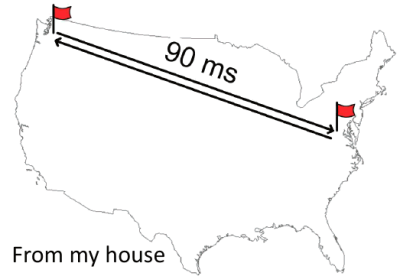
The problem is it’s been like this for well over a decade. This is about the same latency that Stuart Cheshire found in 1996. This is important because as developers we know that network latency matters when it comes to building a responsive web app.
With that backdrop, John launches into a history of TCP that leads us to the current state of network latency. The Internet was born in September of 1981 with RFC 793 documenting the Transmission Control Protocol, better known as TCP.
Given the size of the TCP window (64 kB) there was a chance for congestion, as noted in Congestion Control in IP/TCP Internetworks (RFC 896):
Should the round-trip time exceed the maximum retransmission interval for any host, that host will begin to introduce more and more copies of the same datagrams into the net. The network is now in serious trouble. Eventually all available buffers in the switching nodes will be full and packets must be dropped. Hosts are sending each packet several times, and eventually some copy of each packet arrives at its destination. This is congestion collapse.
This condition is stable. Once the saturation point has been reached, if the algorithm for selecting packets to be dropped is fair, the network will continue to operate in a degraded condition. Congestion collapse and pathological congestion are not normally seen in the ARPANET / MILNET system because these networks have substantial excess capacity.
Although it’s true that in 1984, when RFC 896 was written, the Internet had “substantial excess capacity”, that quickly changed. In 1981 there were 213 hosts on the Internet. But the number of hosts started growing rapidly. In October of 1986, with over 5000 hosts on the Internet, there occurred the first in a series of congestion collapse events.

This led to the development of the TCP slow start algorithm, as described in RFCs 2581, 3390, and 1122. The key to this algorithm is the introduction of a new concept called the congestion window (cwnd) which is maintained by the server. The basic algorithm is:
- initalize cwnd to 3 full segments
- increment cwnd by one full segment for each ACK
TCP slow start was widely adopted. As seen in the following packet flow diagram, the number of packets starts small and doubles, thus avoiding the congestion collision experienced previously.
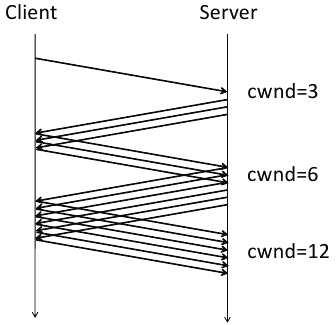
There were still inefficiencies, however. In some situations, too many ACKs would be sent. Thus we now have the delayed ACK algorithm from RFC 813. So the nice packet growth seen above now looks like this:
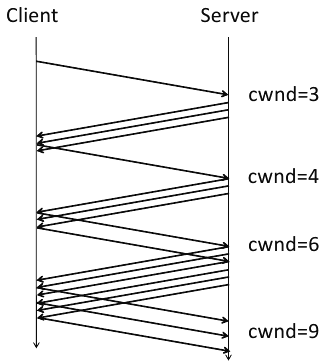
At this point, after referencing so many RFCs and showing numerous ACK diagrams, John aptly asks, “Why should we care?” Sadly, the video stops at this point around slide 160. But if we continue through the slides we see how John brings us back to what web developers deal with on a daily basis.
Keeping in mind that the size of a segment is 1460 bytes (“1500 octets” as specified in RFC 894 minus 40 bytes for TCP and IP headers), we see how many roundtrips are required to deliver various payload sizes. (I overlaid a kB conversion in red.)
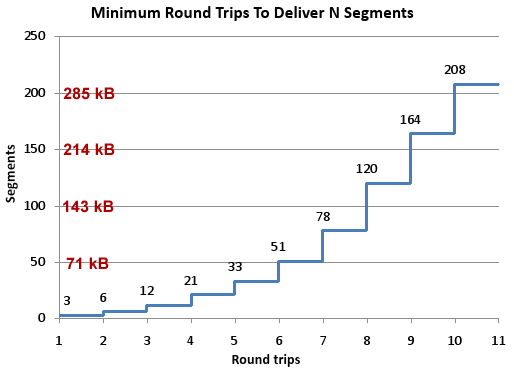
John’s conclusion is that “TCP slow start means that network latency strictly limits the throughput of fresh connections.” He gives these recommendations for what can be done about the situation:
- Carefully consider every byte of content
- Think about what goes into those first few packets
- 2.1 Keep your cookies small
- 2.2 Open connections for assets in the first three packets
- 2.3 Download small assets first
- Accept the speed of light (move content closer to users)
All web developers need at least a basic understanding of the protocol used by their apps. John delivers a great presentation that is informative and engaging, with real takeaways. Enjoy!
Velocity: Top 5 Mistakes of Massive CSS
Nicole Sullivan and Stoyan Stefanov had the #3 highest rated session at Velocity – The Top 5 Mistakes of Massive CSS. Nicole (aka, “stubbornella”) wrote a blog post summarizing their work. The motivator for paying attention to CSS are these stats that show how bad things are across the Alexa Top 1000:
- 42% don’t GZIP CSS
- 44% have more than 2 CSS external files
- 56% serve CSS with cookies
- 62% don’t minify
- 21% have greater than 100K of CSS
Many of these problems are measured by YSlow and Page Speed, but the solutions still aren’t widely adopted. Nicole goes on to highlight more best practices for reducing the impact of CSS including minimizing float and using a reset stylesheet.
Checkout the slides and video of Nicole and Stoyan’s talk to learn how to avoid having CSS block your page from rendering.
| Choose Your Own Adventure | Adam Jacob | Opscode |
| TCP and the Lower Bound of Web Performance | John Rauser | Amazon |
| The Top 5 Mistakes of Massive CSS | Nicole Sullivan | Consultant |
| Building Performance Into the New Yahoo! Homepage | Nicholas Zakas | Yahoo! |
| Hidden Scalability Gotchas in Memcached and Friends | Neil Gunther | Performance Dynamics Company |
| Internet Explorer 9 | Jason Weber | Microsoft |
| Creating Cultural Change | John Rauser | Amazon |
| Scalable Internet Architectures | Theo Schlossnagle | OmniTI |
| Ignite Velocity | Andrew Shafer | Cloudscaling |
| The Upside of Downtime: How to Turn a Disaster Into an Opportunity | Lenny Rachitsky | Webmetrics/Neustar |
| Metrics 101: What to Measure on Your Website | Sean Power | Watching Websites |
| The 90-Minute Optimization Life Cycle: Fast by Default Before Our Eyes? | Joshua Bixby | Strangeloop Networks |
| Progressive Enhancement: Tools and Techniques | Anne Sullivan | |
| Chrome Fast. | Mike Belshe |
Back to blogging after Velocity
The last few weeks have been hectic. I was in London and Paris for 10 days. I returned a day before Velocity started. Most of you experienced or have heard about the awesomeness that was Velocity – great speakers, sponsors, and attendees. Right after Velocity I headed up to Foo Camp at O’Reilly HQ. This week I’ve been catching up on all the email that accumulated over three weeks.
During this time blogging has taken a backseat. But now that my head is above water I want to start relaying some of the key takeaways from Velocity. I wrote my Velocity wrap-up and mentioned my favorite sessions. But here are the top 10 sessions based on the attendee ratings:
- Choose Your Own Adventure by Adam Jacob, Opscode (unofficial video snippets)
- TCP and the Lower Bound of Web Performance by John Rauser, Amazon (slides)
- The Top 5 Mistakes of Massive CSS by Nicole Sullivan, consultant and Stoyan Stefanov, Yahoo! (video)
- Building Performance Into the New Yahoo! Homepage by Nicholas Zakas, Yahoo! (slides)
- Hidden Scalability Gotchas in Memcached and Friends by Neil Gunther Performance Dynamics and Shanti Subramanyam and Stefan Parvu, Oracle (video)
- Internet Explorer 9 by Jason Weber, Microsoft (slides)
- Creating Cultural Change by John Rauser, Amazon (video)
- Scalable Internet Architectures by Theo Schlossnagle, OmniTI (slides)
- The Upside of Downtime: How to Turn a Disaster Into an Opportunity by Lenny Rachitsky, Webmetrics/Neustar (video, slides)
- Tied for #10:
- Metrics 101: What to Measure on Your Website by Sean Power, Watching Websites (slides)
- The 90-Minute Optimization Life Cycle: Fast by Default Before Our Eyes? by Joshua Bixby and Hooman Beheshti, Strangeloop Networks
- Progressive Enhancement: Tools and Techniques by Anne Sullivan, Google (slides)
- Chrome Fast. by Mike Belshe, Google (slides)
Some things to highlight: Adam Jacob is an incredible speaker – insightful and funny. John Rauser is the speaker I enjoyed the most – he shows up twice at #2 and #7. Two of the browser presentations registered. The workshops this year were incredible and very well attended – four of them registered in the top 10 (#8, #10a, #10b, and #10c). Annie Sullivan rated high and it was her first time speaking at a conference.
The last two years at Velocity we’ve only been able to videotape the talks in one room, so this year that means about a third of the talks were videotaped. Four of these top rated sessions were taped. Next year I’ll try to get more of the top speakers in the video room. I’ve asked the five speakers without slides to upload them to the Velocity web site. Check back next week if you want those.
I actually feel electricity running up and down my spine looking over these talks. To think I had something to do with pulling these gurus together and offering a place for them to share what they know – it’s humbling and exhilarating at the same time. I’ll be doing some more Velocity-related posts on specific sessions next week, so stay tuned.
| Choose Your Own Adventure | Adam Jacob | Opscode |
| TCP and the Lower Bound of Web Performance | John Rauser | Amazon |
| The Top 5 Mistakes of Massive CSS | Nicole Sullivan | Consultant |
| Building Performance Into the New Yahoo! Homepage | Nicholas Zakas | Yahoo! |
| Hidden Scalability Gotchas in Memcached and Friends | Neil Gunther | Performance Dynamics Company |
| Internet Explorer 9 | Jason Weber | Microsoft |
| Creating Cultural Change | John Rauser | Amazon |
| Scalable Internet Architectures | Theo Schlossnagle | OmniTI |
| Ignite Velocity | Andrew Shafer | Cloudscaling |
| The Upside of Downtime: How to Turn a Disaster Into an Opportunity | Lenny Rachitsky | Webmetrics/Neustar |
| Metrics 101: What to Measure on Your Website | Sean Power | Watching Websites |
| The 90-Minute Optimization Life Cycle: Fast by Default Before Our Eyes? | Joshua Bixby | Strangeloop Networks |
| Progressive Enhancement: Tools and Techniques | Anne Sullivan | |
| Chrome Fast. | Mike Belshe |
